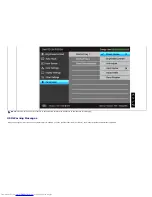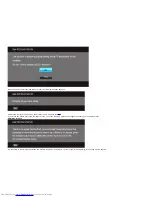
Product Specific Problems
Specific Symptoms
What You Experience
Possible Solutions
Screen image is too small
Image is centered on screen, but does
not fill entire viewing area
Check the Scaling Ratio setting in the Image Setting OSD.
Reset the monitor to Factory Settings.
Cannot adjust the monitor with the
buttons on the front panel
OSD does not appear on the screen
Turn off the monitor, unplug the power cord, plug it back, and then turn on the monitor.
Check whether the OSD menu is locked. If yes, press and hold the button above the Power button for 10
seconds to unlock (for more information, see
Menu Lock
).
No Input Signal when user controls are
pressed
No picture, the LED light is blue.
Check the signal source. Ensure the Computer is not in the power saving mode by moving the mouse or
pressing any key on the keyboard.
Check whether the signal cable is plugged in properly. Re-plug the signal cable if necessary.
Reset the computer or video player.
The picture does not fill the entire
screen.
The picture cannot fill the height or
width of the screen
Due to different video formats (aspect ratio) of DVDs, the monitor may display in full screen.
Run the built-in diagnostics.
NOTE:
When choosing DVI-D mode,
the
Auto Adjust
function will not be available.
Universal Serial Bus (USB) Specific Problems
Specific Symptoms
What You Experience
Possible Solutions
USB interface is not working
USB peripherals are not working
Check that your monitor is turned ON.
Reconnect the upstream cable to your computer.
Reconnect the USB peripherals (downstream connector).
Switch off and then turn on the monitor again.
Reboot the computer.
Some USB devices like external portable HDD require higher electric current; connect the device directly to the
computer system.
High Speed USB 2.0 interface is slow. High Speed USB 2.0 peripherals
working slowly or not working at all
Check that your computer is USB 2.0-capable.
Some computers have both USB 2.0 and USB 1.1 ports. Ensure that the correct USB port is used.
Reconnect the upstream cable to your computer.
Reconnect the USB peripherals (downstream connector).
Reboot the computer.
Dell™ Soundbar Problems
Common Symptoms
What You Experience
Possible Solutions
No Sound
No power to Soundbar - the power
indicator is off
Turn the Power/Volume knob on the Soundbar clockwise to the middle position; check if the power indicator
(Blue LED) on the front of the Soundbar is illuminated.
Confirm that the power cable from the Soundbar is plugged into the adapter.
No Sound
Soundbar has power - power indicator
is on
Plug the audio line-in cable into the computer's audio out jack.
Set all Windows volume controls to their maximum.
Play some audio content on the computer (i.e. audio CD, or MP3).
Turn the Power/Volume knob on the Soundbar clockwise to a higher volume setting.
Clean and reseat the audio line-in plug.
Test the Soundbar using another audio source (i.e. portable CD player).
Distorted Sound
Computer's sound card is used as the
Clear any obstructions between the Soundbar and the user.





































